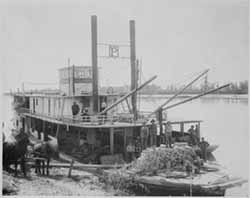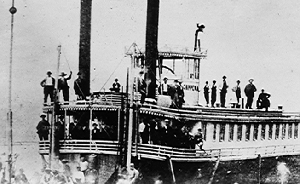Steamboating on the Missouri River
Updated: August 7, 2020

For nearly one hundred years traveling by boat up and down the Missouri River was how most people made their way to Montana. It was the primary pathway for expansion into the West until the railroad boom in the 1800s. Among the early history-makers to brave this river were Meriwether Lewis and William Clark. Known as “Old Misery” and “Big Muddy” to early explorers and fur trappers, the Missouri River’s treacherous currents and unpredictable moods made the journey up its waters in keelboats heavy with supplies extremely dangerous.
In 1819, steamboats left St. Louis bound for the mouth of the Yellowstone River. The waters of the Missouri River, however, proved to be too rough. Of the four in the fleet of steamboats, only one made it as far as the fort at Council Bluffs in Nebraska. Before 1864 there had only been six steamboat arrivals at Fort Benton. Between 1866 and 1867 there were only 70.
On July 2, 1860, the American Fur Trade Company steamboats Chippewa and Keywest arrived at the trading post of Fort Benton. Later that summer Lieutenant John Mullan, of the US Army engineers, finished building the first trail between Fort Walla Walla in Washington and Fort Benton. This new trail was faster than the Oregon Trail. People could now get to Montana and father west much more easily than before. Tens of thousands of miners and immigrants traveled along these routes. They discovered gold and Montana exploded into being.

Fort Benton was Montana’s commercial center before the big building boom of the early 1880s. Fort Benton was a significant western outpost during the roaring days of river trade when two governments and settlers of both the United States and Canada, as well as half a dozen Indian nations, turned to the Missouri River steamboats for transportation and trade. At times there were as many as forty steamboats on the Missouri between Fort Benton and the mouth of the Yellowstone.
After the Civil War, steamboats gliding along on the Missouri River became a common sight. Their design was different than that of earlier steamboats though. These new “mountain boats” were designed specifically for use in Montana’s rivers. They had few of the fancy fittings that the boats back east had because light weight was important on the Missouri. They were about 140 to 170 feet long and 30 feet wide. With a shallow hull, “spoon-bill” shaped bow, and broad beams, they could carry 200 tons of cargo though waist-deep water, safely navigating over anything from sandbars to whitewater rapids. In addition, this type of vessel was less expensive to fuel and much easier to steer.
Steamboat crews consisted of three different categories: Steamboat mates, firemen, and roustabouts. First, the steamboat mates were in charge of making sure the roustabouts did their jobs. The roustabouts in turn were the work force behind the power of a steamboat. They pushed the vessel over sandbars, off snags, and through newly formed ice on the river. Firemen had the task of watching for fire on the ship. Boilers in the steam engines often blew up and caused fires, especially on earlier steamboats that lacked pressure gages. The firemen had shifts of just a few hours at a time because they had to be alert and ready to put a fire out at any moment during their shift.
These “mountain boats” meant business—literally! Steamboat captains in the late 1860s could charge as much as $1,200 every month for their services. They had to be extremely skilled captains and a good hand at striking a deal with merchants willing to take the risks of sending their goods on the Missouri River for a huge pay off. The profits of a successful trip from St Louis to Fort Benton were more than worth it, even considering that the trip took about two to three months. The fare for each passenger was $300, plus a steamboat could carry cargo worth a profit of up to $40,000, which was a huge amount of money at the time.
Updated: August 7, 2020

